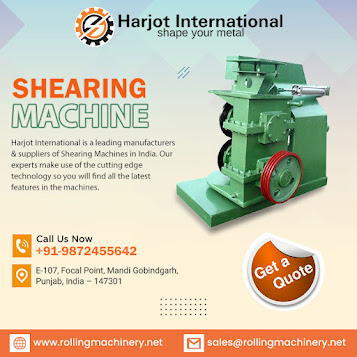Shearing Machine: Its Working Process And Classification
If you want to buy an industrial Shearing Machine to grow your business,
then first you should have information and understanding about it. Many
individuals are not aware of the fundamentals and different types of sheet
metal shear machines.
This blog discusses the shearing device in
detail, including its working process, and much more. So, keep on reading to
learn further!
What is a Shearing Machine?
A shear machine applies shearing force to
metal sheets of varying thicknesses by using a reasonable blade gap to cause
the sheets to break and divide according to the desired size. This machine has
an upper blade that moves and a stationary bottom blade.
Furthermore, Shearing Machine Manufacturers in India made this equipment primarily for application in
the metal processing sector. The products are widely utilized in a variety of
sectors, including aviation, light industry, metallurgy, chemical industry,
construction, shipbuilding, automotive, electric power, electrical appliances,
decoration, and other fields to supply the necessary specialized machinery and
whole sets of equipment.
Working Principle Of Shearing Machine
When cutting a plate, a shear machine
reciprocates one blade in a linear motion with the other blade. After shearing,
the machine should be able to guarantee the parallelism and straightness of the
shearing surface of the sheared sheet, reduce the sheet's deformation, and
produce high-quality workpieces.
The lower blade of the shearing or cutting
machine is fastened to the work table, while the upper blade is secured to the
knife holder. To avoid scratching the board when sliding across it, the
worktable has a holding ball installed. The motor adjusts the plate's position,
which is set via the rear gauge.
Additionally, the pressing cylinder is used
to secure the sheet and keep it from moving during the shearing operation.
Guardrails are industrial safety equipment that helps to prevent accidents. The
return journey is typically made with nitrogen, which is rapid and has a low
environmental impact.
Classification Of Shears Or Shearing Machine
General shears are classified as pedal type
(manpower), mechanical shears, electric shears, hydraulic swing shears, and
guillotine shears.
Nevertheless, based on how the shearing machine works there are two
types:
●
Mechanical shear machines: divided into upper
drive and lower drive.
●
Hydraulic shear machines: divided into
pendulum and gate shearing devices.
Based on its cutting method, the shearing machine is classified into
two types:
●
Linear shear machines
These are used to cut metal thicker than
2mm; they can be powered by hydraulics or operated manually to cut thinner
metal.
●
Circular shear machines
Circular shears are powered by electric
motors and are used to cut circular blanks and rings from metal. The best
metals for shearing include bronze, aluminum, brass, and mild steel. Metal
shearing is inexpensive and simple, hence it is popular in business and even at
home.
Based on their designs, shearing machines are classified into the
following categories:
●
Bench shearing device
The machine is installed on a tabletop to
boost its mechanical capabilities. It is used to carve rough forms out of
medium-sized metal.
●
Guillotine
Electric shears are made up of a shearing
table that holds the material to be sheared, a holding mechanism that holds the
material to prevent movement, a measurement device that ensures the material is
in the correct position, and upper and lower blades for cutting.
●
Power shears
These shears are designed to shear big
chunks of metal, regardless of size. They can also be hydraulically propelled
to cut metal that is too large to transport.
●
Throat
It is used for intricate cuts and curves.
To Finish
If you are searching for Shearing Machine Suppliers in India, simply
contact Harjot International. We
also provide exclusive solutions tailored to your specific industrial needs.
Additionally, the Straightening Machine,
bar bundling machine, etc. are also available on our website.




Comments
Post a Comment